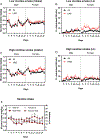Adolescent nicotine and tobacco smoke exposure enhances nicotine self-administration in female rats
- PMID: 32702403
- PMCID: PMC7660018
- DOI: 10.1016/j.neuropharm.2020.108243
Adolescent nicotine and tobacco smoke exposure enhances nicotine self-administration in female rats
Abstract
Most people start experimenting with tobacco products or e-cigarettes in early adolescence and become habitual smokers in late adolescence or adulthood. These studies investigated if exposure to tobacco smoke or nicotine during early and mid-adolescence affects nicotine intake in late adolescence and early adulthood. Male and female rats were exposed to tobacco smoke from low- and high-nicotine SPECTRUM cigarettes or nicotine (0.3 mg/kg, twice a day) from postnatal day (P) 24-42. The self-administration sessions started at P55. The rats self-administered nicotine for 14-15 days under a fixed-ratio 1 schedule, and on the first day, the maximum number of infusions was twenty. Exposure to smoke from high, but not low, nicotine cigarettes during adolescence increased nicotine self-administration in female but not male rats. Adolescent treatment with nicotine facilitated nicotine self-administration. On the first day of nicotine self-administration, nicotine-treated rats reached the maximum number of infusions before the saline-treated control rats. Nicotine intake was also higher in the nicotine-treated female rats than in the saline-treated females. There was no sex difference in nicotine intake in controls when the data from the studies were combined. Smoke exposure led to a dose-dependent increase in plasma nicotine and cotinine levels in adolescent rats. Exposure to smoke from high-nicotine cigarettes and 0.3 mg/kg of nicotine led to plasma nicotine and cotinine levels that are similar to those in tobacco users. These findings indicate that in females, but not males, exposure to nicotine during adolescence may facilitate smoking and e-cigarette use later in life.
Keywords: Adolescent; Nicotine; Rats; Self-administration; Sex differences; Tobacco smoke.
Copyright © 2020. Published by Elsevier Ltd.
Figures





References
-
- Adriani W, Deroche-Gamonet V, Le MM, Laviola G, Piazza PV, 2006. Preexposure during or following adolescence differently affects nicotine-rewarding properties in adult rats. Psychopharmacology (Berl) 184, 382–390. - PubMed
-
- Benowitz NL, Lake T, Keller KH, Lee BL, 1987. Prolonged absorption with development of tolerance to toxic effects after cutaneous exposure to nicotine. Clinical Pharmacology & Therapeutics 42, 119–120. - PubMed
Publication types
MeSH terms
Substances
Grants and funding
LinkOut - more resources
Full Text Sources
Medical

